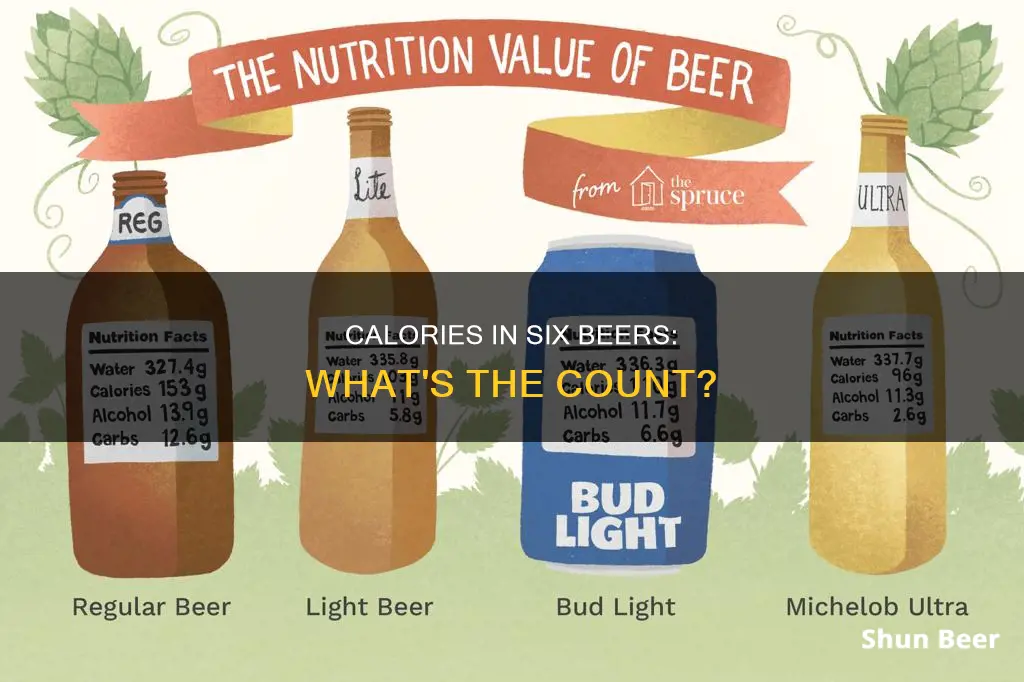
Beer is a popular drink worldwide, but it's important to be aware of its calorie content. Alcoholic beverages can quickly add 500 or more calories to your daily intake, and beer tends to be higher in calories than wine or spirits. The calories in beer come mainly from carbs and alcohol, with about 60% from alcohol and 40% from carbs. The calorie count varies depending on the type of beer, with craft, seasonal, and high-alcohol beers generally containing more calories than lighter options. Non-alcoholic beers usually have fewer calories. So, how many calories are in 6 beers? Well, that depends on the type of beer. A standard 12-ounce serving of popular beers in the US ranges from around 95 to just under 150 calories. So, 6 beers could mean consuming anywhere from 570 to 900 calories or more!
What You'll Learn

Calorie content varies by type of beer
The calorie content of beer varies depending on the type and specific brew. Beer is typically made from fermented grain, and the calories come predominantly from carbs and alcohol. The more alcohol a beer contains, the more calories it will have. The alcohol content can be determined by the alcohol by volume (ABV) measure, usually located on the can or bottle. A higher ABV percentage indicates a higher-calorie content.
For example, a 12-ounce lager with 4.5% ABV will have approximately 135 calories, while a 12-ounce barrel-aged stout with 10.5% ABV will have about 315 calories. A simple formula to estimate the number of calories in a beer is: ABV% x 2.5 x ounces of beer. So, if you have a 16-ounce beer with 6% ABV, it will contain about 240 calories.
Different styles of beer, such as lagers, ales, and stouts, can also vary in their calorie content. Generally, lagers have fewer calories than ales, and ales have fewer calories than stouts. However, there are exceptions, and even within these categories, there can be significant variations. For instance, IPAs can range from lower-alcohol "session" IPAs with around 140 calories to heavy hitters like double or imperial IPAs, which can pack 200 to 300 calories in a 12-ounce serving.
Light beers typically have fewer calories due to reduced carbohydrate and alcohol content. Very low-alcohol beers, such as Miller 64 (2% to 3% ABV), start at around 60 calories in a 12-ounce serving. Most light beers with 4% ABV have about 100 calories, while some, like Bud Light Next, reduce calories further by eliminating carbs, resulting in only 80 calories.
So, when it comes to beer, the calorie content can vary significantly depending on the style, alcohol content, and specific brew. To make a more informed choice, it's helpful to check the ABV and remember that a higher ABV generally indicates a higher-calorie beer.
Calorie Counting: Beer Stubbie Edition
You may want to see also

Alcohol content impacts calories
The number of calories in beer depends on its alcohol content. The higher the alcohol content, the more calories the beer will have. This is because about 60% of calories in beer come from alcohol, with 40% coming from carbohydrates. The alcohol by volume (ABV) measure, usually located on the can or bottle, indicates the relative amount of alcohol in a beer.
For example, a 12-ounce lager with 4.5% ABV will have around 135 calories, while a 12-ounce barrel-aged stout with 10.5% ABV will have about 315 calories. A typical 12-ounce beer with 5% ABV has approximately 150 calories, which is similar to the calorie count of a can of Coke.
If you are watching your calorie intake, opting for low-alcohol beers or alcohol-free beers can be a good strategy. These beers usually have fewer calories than their higher-alcohol counterparts. For instance, very low-alcohol beers (2% to 3% ABV) like Miller 64 have around 60 calories in a 12-ounce serving. Most light beers (4% ABV) have about 100 calories, and low-calorie IPAs can have as few as 100 calories or less.
On the other hand, beers with higher alcohol content will have a higher number of calories. Regular beers with an ABV of around 5% will have approximately 150 calories, while heavy hitters like regular IPAs, double or imperial IPAs, and Belgian-style Trippels, with an ABV ranging from 7% to 11%, can pack 200 to 300 calories in a 12-ounce serving.
So, if you're looking to make more informed choices about your beer consumption, pay close attention to the ABV and remember that the higher the ABV, the more calories you're likely to consume.
Calories in Bengali Tiger Beer: All You Need to Know
You may want to see also

Nutritional value of beer
Beer is made from the fermentation of grains, and it is a popular alcoholic beverage. While beer is often viewed as empty calories, it does contain some nutritional value.
A 12-ounce (355 mL) can or bottle of beer typically contains less than 1 gram of fat, about 13 grams of carbohydrates, less than 1 gram of fibre, and less than 1 gram of sugar. Beer is also a source of potassium, calcium, thiamine, iron, zinc, folate, niacin, magnesium, and B vitamins. These vitamins and minerals are derived from the cereal grains and yeast used in the brewing process.
However, it is important to note that the nutritional content of beer can vary depending on the type and brand. For example, dark beers tend to have more carbohydrates due to the addition of malts during brewing. Additionally, craft, seasonal, and high alcohol content beers tend to have more calories than lighter beers.
When it comes to calories, a standard 12-ounce (355 mL) beer contains around 153 calories. Therefore, six beers would amount to approximately 929 calories. It is worth mentioning that this calorie count can vary depending on the specific type and brand of beer.
While moderate beer consumption may offer some health benefits, such as improved heart health, better blood sugar control, stronger bones, and reduced dementia risk, excessive drinking can lead to negative health consequences. These include an increased risk of depression, liver disease, weight gain, certain cancers, and other health issues.
In conclusion, while beer does have some nutritional value, it should not be relied upon as a significant source of nutrients. Whole foods like fruits and vegetables are far superior sources of vitamins and minerals. Additionally, excessive alcohol consumption can lead to various health problems, so it is important to drink in moderation.
Calories in Lone Star Beer: Nutritional Breakdown
You may want to see also

Calories in beer vs other drinks
Beer is a popular alcoholic drink made from fermented grain. The calorie content in beer varies depending on its type and alcohol content. On average, a 12-ounce beer contains around 150 calories, with most of the calories coming from carbs and alcohol. A 6-pack of beer can contain up to 929 calories.
When compared to other drinks, beer tends to have a higher calorie count than wine or spirits like whiskey. A standard 7-ounce mixed drink and a 12-ounce beer have a similar calorie count. However, pure spirits, such as whiskey, vodka, or gin, have fewer calories per serving than beer. A shot of straight liquor generally has fewer calories and carbohydrates than a 12-ounce beer.
Cocktails and mixed drinks can have especially high-calorie counts due to the addition of soda, juice, cream, or ice cream. A pint of lager, a typical beer, has about 180 calories, which is the same as a slice of pizza. Stouts and ales have around 250 calories, comparable to a whole bagel, while a pint of cider has about 216 calories, similar to a sugared doughnut.
Non-alcoholic drinks, such as coffee and soft drinks, also contribute to our daily calorie intake. Black coffee is calorie-free, but adding sugar, cream, or milk increases its calorie count. Soft drinks are often considered "empty calories" due to their high processing and low nutritional value. Natural juices, while high in calories and sugar, can provide vitamins and micronutrients.
In summary, beer's calorie content varies depending on its type and alcohol content, but it generally has more calories than wine or spirits. Cocktails and mixed drinks can be high in calories, and non-alcoholic drinks like coffee and soft drinks also contribute to our daily calorie intake. Making mindful choices and practising moderation can help maintain a healthy weight.
Beer Calories: Little Brown Note's Secrets Unveiled
You may want to see also

Calculating calories in beer
Beer is made from fermented grain, and the calories in beer come predominantly from alcohol and, to a lesser extent, carbohydrates. The number of calories in a beer depends on its alcohol content, with higher alcohol content leading to more calories. For example, a 12-ounce lager with 4.5% ABV has approximately 135 calories, while a 12-ounce barrel-aged stout with 10.5% ABV has about 315 calories.
A simple formula to calculate the calories in a beer is:
> ABV% x 2.5 x ounces of beer
Using this formula, a 16-ounce beer with 6% ABV contains approximately 240 calories. The ABV, or alcohol by volume, can usually be found on the beer can or bottle.
It's important to note that beer tends to have more calories than other beverages like wine or spirits. A typical 12-ounce beer has about the same number of calories as a can of Coke, which is around 140. However, some beers can have twice that amount.
If you're watching your calorie intake, opting for low-ABV, alcohol-free, or light beers can be a good strategy. Light beers typically have fewer carbohydrates and more water, resulting in a lower overall calorie count. Additionally, non-alcoholic beers can have some health benefits while still allowing you to enjoy the taste of beer.
Air-Fried Beer-Battered Onion Rings: A Calorie Conundrum
You may want to see also
Frequently asked questions
This depends on the type of beer. A standard 12-ounce beer with 5% ABV contains about 150 calories, so 6 of these would be 900 calories.
The healthiest way to drink alcohol is to be mindful of how much you're drinking. Drinking a glass of water between each alcoholic beverage and using a pre-measured cup can help you keep an eye on your portion sizes.
Beers with lower alcohol content tend to be lower in calories. Some examples include Bud Light (110 calories), Busch Light (95 calories), and Miller Lite (96 calories).
To estimate the number of calories in a standard beer, you can use the following calculation: Beer calories = ABV% x 2.5 x ounces of beer.
Some strategies include drinking slowly, managing food choices, and seeking out low-ABV beers with high flavour.







